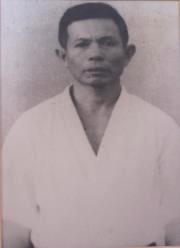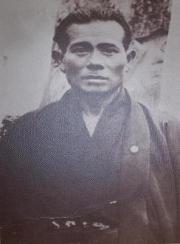|
A notable example is Master Shinyu Gushi, the only Okinawan master residing in the United States, who formed his own association and style name: RyuKoKaku (dragon, tiger, and crane), the name being descriptive of the fighting styles of the animals on which the style is based.† Gushi-senseiís style preserves the original style as passed to him by the above-referenced direct students of Kanbun Uechi: Uehara-sensei, Shinjo-sensei, Kanei Uechi-sensei, and Itokazu-sensei.†
The core of Pangainoon and descendant styles is the kata (form) sanchin (three challenges), a moving meditation.† Diligent study and practice will yield a strong, conditioned body, a calm, aware mind, and an indomitable fighting spirit.† Sanchin kata is laden with all of the fighting principles of the style, including keeping oneself protected, moving effectively, and swiftly executing power.† The hard and soft elements, and the ability to switch quickly between the two, so integral to the style, can be mastered through sanchin.
|
|
History of Style |


|
Grandmaster Kanbun Uechi |
|
Grandmaster Kanei Uechi |




|
Famous Picture of Master Shinyu Gushi Performing Sanchin Gami as |
|
In the late 19th and early 20th century Okinawan Uechi-ryu (style) founder Kanbun Uechi (1877-1948) studied a system of Chinese boxing in Southern China from his teacher Shushiwa (Japanese pronunciation), and brought the system, based on the dragon, tiger, and crane, and known as Pangainoon (half hard, half soft) to Japan, and later Okinawa. The system, at first taught in secret to only carefully-screened students, included the katas (forms) Sanchin, Seisan, and Sanseiryu, and conditioning exercises still practiced today as the styleís core. |
|
Kanbunís son, Kanei Uechi (1911-1991), having studied under his father from the age of sixteen, became the second grandmaster in 1948, upon Kanbunís death.† Kanei Uechi sought to and succeeded in, popularizing his fatherís karate worldwide, while retaining its authenticity.† Kanei-sensei (honorific for teacher) with the assistance of several other senior students of his father (Saburo Uehara, Seiki Itokazu, Seiyu Shinjo, and others) added five kata, and supplementary exercises and drills that are still practiced today.
Many of Kanei-senseiís senior students went on to form their own associations, and in some instances made the administrative change of renaming the style (e.g. Shohei-ryu, Pangainoon, etc.).† By whatever name however, the style and its essence remains relatively unchanged from Uechi-ryu. |